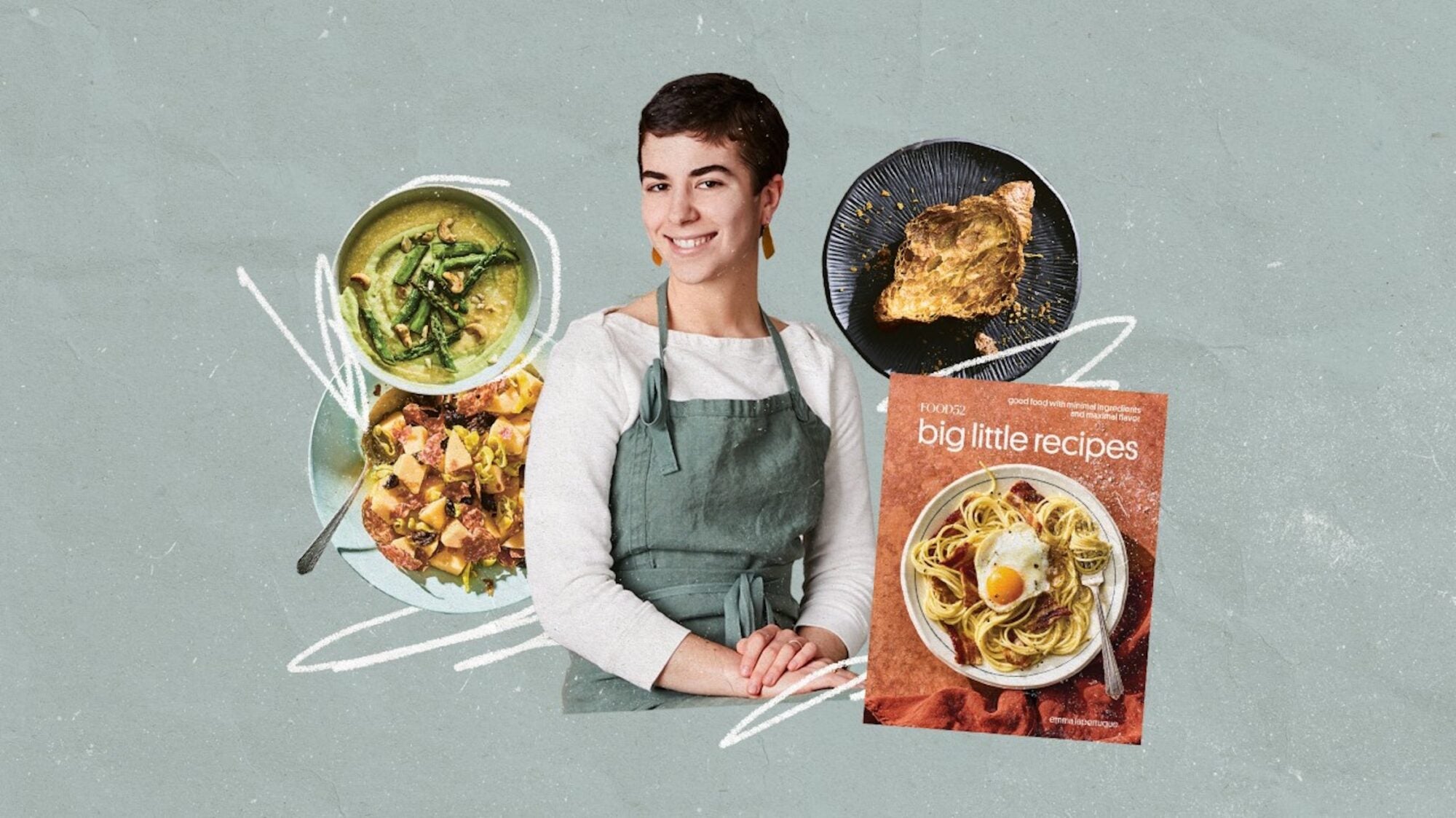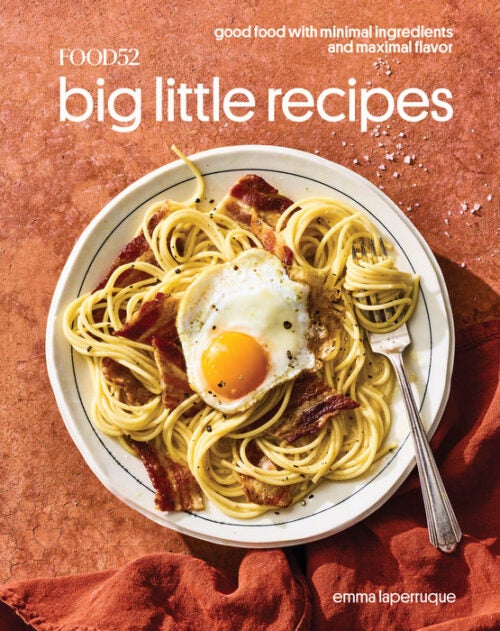
A new cookbook, Big Little Recipes, promises simple recipes for not-so-simple times.
If you’ve ever read Big Little Recipes, Emma Laperruque’s column on Food52, you’ll notice some recurring themes. They usually include one or more of the following: short ingredient lists, clever flavor combinations that make you wish you had thought of them first, and, most important, recipes that remind you how fun and unfussy cooking can be.
Laperruque’s new book, also called Big Little Recipes, is full of refreshing ways to use ordinary ingredients. Wedges of grocery store hothouse tomato are sprinkled with sugar to bring out their natural sweetness and juiciness, to eat on fried toast with burrata. Ripe canteloupe is turned into a salty, Italian-inflected fruit salad with salami and pepperoncini. And smashed potatoes, fried in a skillet, become the base of a hearty salad. I talked to Laperruque about some of these invaluable techniques, and why she loves recipes where a few small ingredients work together to create big flavors.
So, what is a big little recipe?
The short answer: good food with as few ingredients as humanly possible. The long answer: a lot of things! I’m always asking myself questions during recipe development: Do I need this extra herb? Would water work as well as stock? I’m using radishes, how can I also use their greens? I’m using pickles, how can I also use their brine? So maybe it’s pasta where corn becomes a silky sauce and a crunchy topping. Or a really creamy tomato soup that doesn’t need any cream. Or a strawberry crumble where you ditch the flour in the streusel and swap in pretzels instead.
What are some examples of big little recipes from other cookbooks or authors that have inspired you over the years?
Oh, so many. How much time do we have? Renee Erickson’s sautéed dates. Edna Lewis’s skillet scallions. Marcella Hazan’s buttery tomato sauce. Samin Nosrat’s buttermilk-brined chicken. David Lebovitz’s chocolate sorbet. I could keep going. This year, we started featuring guest columnists in Big Little Recipes, where cookbook authors share their own dishes with five ingredients or fewer. Hetty McKinnon shared her mom’s steamed eggs. Vallery Lomas shared a one-bowl blueberry buckle. It’s been so awesome seeing the column through other people’s eyes.
One of the things I love about both your column on Food52 and the book is that so many of these recipes think outside of the traditional meal paradigm. Instead of a meat, a starch, and a vegetable, it’s like, “Oh yeah, I can just have steak and a big pile of parsley for dinner.” Do you think there’s a shift happening in how we think about meal formats?
Totally. Where do you draw the line between breakfast and lunch and dinner? Why do we have salad plates and dinner plates? What makes a side a . . . side? There’s this fun section in Rebekah Peppler’s new book, À Table, about snack dinner and how that’s way more fun than dinner-dinner, and what is dinner anyway? I love that. That feels like real life to me. And I think that’s what I was trying to accomplish, more than anything else, in Big Little Recipes—how can this fit into someone’s real, busy, messy life?
One of the coolest tricks in the book is to sprinkle a little sugar onto fresh tomatoes (like you might with other, sweeter summer fruit). What does this do to the tomatoes, and what other applications have you tried this with (other than the toast in the book)?
Oh, I’m glad that called out to you! The funny thing about working on a cookbook is that it takes years from start to finish, and recipe development is just one stage. I actually did the bulk of my development in the winter—which is definitely not tomato season in New Jersey, where I live. So this was dreamed up with summer produce in mind. How can we make bad tomatoes good and good tomatoes even better?
Sugaring tomatoes does just what it would to strawberries or peaches or whatever fruit is eyeing you up at the farmers’ market: It intensifies the sweetness and creates this crazy-good syrup, like a built-in sauce. Beyond burrata toast, honestly, I can’t think of anything besides a scallion cream cheese bagel, which is very similar to burrata toast—but, wow, I would do anything for a bagel right now.
Part of the emphasis of the book is on doing more with fewer ingredients. Why do you think minimalism has become such a theme in our era of home cooking?
It is such a theme! And way beyond the kitchen, right? There’s minimalist fashion. And minimalist decor. And minimalist decluttering. And minimalist tattoos. But when it comes to cooking, to me, the appeal is usability. There are so many reasons not to cook. There are so many nights I don’t want to cook! I’d rather order pizza. So, whenever I’m working on a recipe, I’m always wondering, how can I make this more appealing than ordering pizza? I want to feel empowered by the ingredients I already have. If that’s just pasta and broccoli and cheese, great! That’s more than enough.
Are there situations in your cooking (or specific dishes you like to cook) when you think that more is actually more?
Definitely. I’m a big believer in everything in moderation, including moderation. These days, almost all of the recipes I develop are five ingredients or fewer, so when I’m not cooking for work, it’s a nice break to use six ingredients, or seven, or seventeen. That’s my wild Friday night these days. Make a martini, turn on some ABBA, follow someone else’s recipe. Have you tried Sohla El-Waylly’s Cashew Milk–Braised Cabbage? It has over a dozen ingredients. And oh my god is it so good.
THREE EXCITING RECIPES FROM BIG LITTLE RECIPES:
- Juicy Canteloupe with Salami, Pepperoncini, and Olives
A salty, peppery mix that will challenge everything you think you know about fruit salad. - Asparagus & Cashews with Green Polenta
This polenta gets its creaminess not from butter but from a smooth blend of asparagus and cashews. - Crunchy Croissant Brittle
Think of this as a low-lift, high-reward version of French toast.
MORE BOOKS TO BUY, READ, AND COOK FROM:
- Last week we spoke to Carla Lalli Music about her latest cookbook, That Sounds So Good.
- Hetty McKinnon’s To Asia, With Love has become a quick classic in many of our kitchens since it came out earlier this year.
- In Sheet Cake, Abigail Johnson Dodge proves that the sheet pan really can do it all.
- In Cooking at Home, David Chang and Priya Krishna embrace frozen foods, the microwave, and improvising as you go.
- Bake your way through Baking with Dorie, the latest book in the Dorie Greenspan canon.
